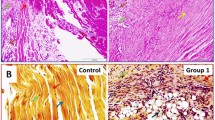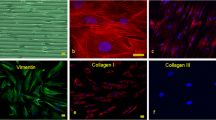Abstract
Modern molecular techniques have highlighted the presence of inflammation throughout the spectrum of tendinopathy. Previous studies have suggested that excessive inflammation in the tendon is a major factor leading to poor clinical treatment. Furthermore, the NLRP3 inflammasome, as a new term, is closely associated with the pathogenesis of many diseases. In the present study, we examined whether the NLRP3 inflammasome contributes to the development of tendinitis and whether cyclic stretching plays a prominent role in inflammation in the tendon. In the present study, we showed that hydrogen peroxide (H2O2) remarkably enhances the expression and release of IL-1β, TNF-α, and IL-6. The maturation of IL-1β, induced by H2O2, depends on the activation of the NLRP3 inflammasome. Cyclic stretching enhances the maturation of IL-1β via promoting H2O2-induced NLRP3 inflammasome activation in tenocytes. Furthermore, we also found that the depolymerization of filamentous actin (F-actin) was required for cyclic stretching-enhanced NLRP3 inflammasome activation. The present study suggests that NLRP3 inflammasome plays an important regulatory role in the pathogenesis of tendinitis. Disruption of the cytoskeleton by cyclic stretching exerts a proinflammatory effect via further activating the NLRP3/IL-1β pathway and hence contributes to tendinitis. These results may provide theoretical support for a new treatment strategy for preventing excessive inflammation in the tendon.






Similar content being viewed by others
References
Riley, G. 2005. Chronic tendon pathology: Molecular basis and therapeutic implications. Expert Reviews in Molecular Medicine 7: 1–25.
Stanley, N.A.A.R.L., and D.J.R. Evans. 2013. Tendinopathy—from basic science to treatment. International Journal of Experimental Pathology 94: A1–A21.
McGonagle, D., H. Marzo-Ortega, M. Benjamin, and P. Emery. 2013. Report on the Second International Enthesitis Workshop. Arthritis and Rheumatism 48: 896–905.
Sugg, K.B., J. Lubardic, J.P. Gumucio, and C.L. Mendias. 2014. Changes in macrophage phenotype and induction of epithelial-to-mesenchymal transition genes following acute Achilles tenotomy and repair. Journal of Orthopaedic Research 32: 944–951.
Lories, R.J., and I.B. McInnes. 2012. Primed for inflammation: Enthesis-resident T cells. Nature Medicine 18: 1018–1019.
Manning, C.N., N. Havlioglu, E. Knutsen, S.E. Sakiyama-Elbert, M.J. Silva, S. Thomopoulos, and R.H. Gelberman. 2014. The early inflammatory response after flexor tendon healing: A gene expression and histological analysis. Journal of Orthopaedic Research 32: 645–652.
Berglund, M., D.A. Hart, and M. Wiig. 2007. The inflammatory response and hyaluronan synthases in the rabbit flexor tendon and tendon sheath following injury. The Journal of Hand Surgery, European Volume 32: 581–587.
Millar, N.L., G.A. Murrell, and I.B. McInnes. 2017. Inflammatory mechanisms in tendinopathy - towards translation. Nature Reviews Rheumatology 13: 110–122.
Lucas, T., A. Waisman, R. Ranjan, J. Roes, T. Krieg, W. Muller, A. Roers, and S.A. Eming. 2010. Differential roles of macrophages in diverse phases of skin repair. Journal of Immunology 184: 3964–3977.
Lin, T.W., L. Cardenas, D.L. Glaser, and L.J. Soslowsky. 2006. Tendon healing in interleukin-4 and interleukin-6 knockout mice. Journal of Biomechanics 39: 61–69.
Hays, P.L., S. Kawamura, X.H. Deng, E. Dagher, K. Mithoefer, L. Ying, and S.A. Rodeo. 2008. The role of macrophages in early healing of a tendon graft in a bone tunnel. The Journal of Bone and Joint Surgery - American Volume 90: 565–579.
Dagher, E., P.L. Hays, S. Kawamura, J. Godin, X.H. Deng, and S.A. Rodeo. 2009. Immobilization modulates macrophage accumulation in tendon-bone healing. Clinical Orthopaedics and Related Research 467: 281–287.
Kawamura, S., L. Ying, H. Kim, C. Dynybil, and S. Rodeo. 2005. Macrophages accumulate in the early phase of tendon–bone healing. Journal of Orthopaedic Research 23: 1425–1432.
Silva, M.J., M.D. Brodt, M.I. Boyer, T.S. Morris, H. Dinopoulos, D. Amiel, and R.H. Gelberman. 1999. Effects of increased in vivo excursion on digital range of motion and tendon strength following flexor tendon repair. Journal of Orthopaedic Research 17: 777–783.
Strowig, T., J. Henao-Mejia, E. Elinav, and R. Flavell. 2012. Inflammasomes in health and disease. Nature 481: 278–286.
Wen, H., J.P. Ting, and L.A. O'Neill. 2012. A role for the NLRP3 inflammasome in metabolic diseases—did Warburg miss inflammation? Nature Immunology 13: 352–357.
Schroder, K., and J. Tschopp. 2010. The inflammasomes. Cell 140: 821–832.
van de Veerdonk, F.L., M.G. Netea, C.A. Dinarello, and L.A. Joosten. 2011. Inflammasome activation and IL-1beta and IL-18 processing during infection. Trends in Immunology 32: 110–116.
Chen, G.Y., and G. Nunez. 2010. Sterile inflammation: Sensing and reacting to damage. Nature Reviews. Immunology 10: 826–837.
de Zoete, M.R., N.W. Palm, S. Zhu, and R.A. Flavell. 2014. Inflammasomes. Cold Spring Harbor Perspectives in Biology 6: a016287.
Chen, Y., A.L. Pitzer, X. Li, P.L. Li, L. Wang, and Y. Zhang. 2015. Instigation of endothelial Nlrp3 inflammasome by adipokine visfatin promotes inter-endothelial junction disruption: Role of HMGB1. Journal of Cellular and Molecular Medicine 19: 2715–2727.
Ratsimandresy, R.A., A. Dorfleutner, and C. Stehlik. 2013. An update on PYRIN domain-containing pattern recognition receptors: From immunity to pathology. Frontiers in Immunology 4: 440.
Martinon, F., A. Mayor, and J. Tschopp. 2009. The inflammasomes: Guardians of the body. Annual Review of Immunology 27: 229–265.
Yu, H.B., and B.B. Finlay. 2008. The caspase-1 inflammasome: A pilot of innate immune responses. Cell Host & Microbe 4: 198–208.
Leemans, J.C., S.L. Cassel, and F.S. Sutterwala. 2011. Sensing damage by the NLRP3 inflammasome. Immunological Reviews 243: 152–162.
Kim, J.Y., Y.G. Lee, M.Y. Kim, S.E. Byeon, M.H. Rhee, J. Park, D.R. Katz, B.M. Chain, and J.Y. Cho. 2010. Src-mediated regulation of inflammatory responses by actin polymerization. Biochemical Pharmacology 79: 431–443.
Kim, M.L., J.J. Chae, Y.H. Park, D. de Nardo, R.A. Stirzaker, H.J. Ko, H. Tye, L. Cengia, L. DiRago, D. Metcalf, A.W. Roberts, D.L. Kastner, A.M. Lew, D. Lyras, B.T. Kile, B.A. Croker, and S.L. Masters. 2015. Aberrant actin depolymerization triggers the pyrin inflammasome and autoinflammatory disease that is dependent on IL-18, not IL-1beta. The Journal of Experimental Medicine 212: 927–938.
Waite, A.L., P. Schaner, C. Hu, N. Richards, B. Balci-Peynircioglu, A. Hong, M. Fox, and D.L. Gumucio. 2009. Pyrin and ASC co-localize to cellular sites that are rich in polymerizing actin. Experimental Biology and Medicine 234: 40–52.
Misawa, T., M. Takahama, T. Kozaki, H. Lee, J. Zou, T. Saitoh, and S. Akira. 2013. Microtubule-driven spatial arrangement of mitochondria promotes activation of the NLRP3 inflammasome. Nature Immunology 14: 454–460.
Man, E.A., Tourlomousis P. SM, S. Achouri, et al. 2014. Actin polymerization as a key innate immune effector mechanism to control Salmonella infection. PNAS 111: 17588–17593.
Taskiran, E.Z., A. Cetinkaya, B. Balci-Peynircioglu, Y.Z. Akkaya, and E. Yilmaz. 2012. The effect of colchicine on pyrin and pyrin interacting proteins. Journal of Cellular Biochemistry 113: 3536–3546.
Fletcher, D.A., and R.D. Mullins. 2010. Cell mechanics and the cytoskeleton. Nature 463: 485–492.
Wickstead, B., and K. Gull. 2011. The evolution of the cytoskeleton. The Journal of Cell Biology 194: 513–525.
Burger, D., C. Fickentscher, P. de Moerloose, and K.J. Brandt. 2016. F-actin dampens NLRP3 inflammasome activity via Flightless-I and LRRFIP2. Scientific Reports 6: 29834.
Chen, W., Y. Deng, J. Zhang, and K. Tang. 2015. Uniaxial repetitive mechanical overloading induces influx of extracellular calcium and cytoskeleton disruption in human tenocytes. Cell and Tissue Research 359: 577–587.
Zhang, B., Q. Luo, Z. Chen, J. Sun, B. Xu, Y. Ju, and G. Song. 2015. Cyclic mechanical stretching promotes migration but inhibits invasion of rat bone marrow stromal cells. Stem Cell Research 14: 155–164.
Jin, J., Q. Yu, C. Han, X. Hu, S. Xu, Q. Wang, J. Wang, N. Li, and X. Cao. 2013. LRRFIP2 negatively regulates NLRP3 inflammasome activation in macrophages by promoting Flightless-I-mediated caspase-1 inhibition. Nature Communications 4: 2075.
Katzel, E.B., M. Wolenski, A.E. Loiselle, P. Basile, L.M. Flick, H.N. Langstein, M.J. Hilton, H.A. Awad, W.C. Hammert, and R.J. O'Keefe. 2011. Impact of Smad3 loss of function on scarring and adhesion formation during tendon healing. Journal of Orthopaedic Research 29: 684–693.
Cilli, F., M. Khan, F. Fu, and J.H.C. Wang. 2004. Prostaglandin E2 affects proliferation and collagen synthesis by human patellar tendon fibroblasts. Clinical Journal of Sport Medicine 14: 232–236.
Candel, S., S. de Oliveira, A. Lopez-Munoz, et al. 2014. TNFa signaling through tnfr2 protects skin against oxidative stress-induced inflammation. PLoS Biology 12: e1001855.
Wang, Y.L., G.Y. Sun, Y. Zhang, J.J. He, S. Zheng, and J.N. Lin. 2016. Tormentic acid inhibits H2O2-induced oxidative stress and inflammation in rat vascular smooth muscle cells via inhibition of the NF-kappaB signaling pathway. Molecular Medicine Reports 14: 3559–3564.
Kim, J.S., Y.H. Lee, Y.U. Chang, and H.K. Yi. 2016. PPARgamma regulates inflammatory reaction by inhibiting the MAPK/NF-kappaB pathway in C2C12 skeletal muscle cells. Journal of Physiology and Biochemistry 73: 49–57.
Young, I.C., S.T. Chuang, C.H. Hsu, Y.J. Sun, and F.H. Lin. 2016. C-phycocyanin alleviates osteoarthritic injury in chondrocytes stimulated with H2O2 and compressive stress. International Journal of Biological Macromolecules 93: 852–859.
Latz, E., T.S. Xiao, and A. Stutz. 2013. Activation and regulation of the inflammasomes. Nature Reviews Immunology 13: 397–411.
Fabio Martinon, K.B., and J. Tschopp. 2002. The inflammasome a molecular platform triggering activation of inflammatory caspases and processing of proIL-beta. Molecular Cell 10: 417–426.
Rathinam, V.A., S.K. Vanaja, and K.A. Fitzgerald. 2012. Regulation of inflammasome signaling. Nature Immunology 13: 333–342.
Martinon, F. 2010. Signaling by ROS drives inflammasome activation. European Journal of Immunology 40: 616–619.
Hoffmann, E.K., S.F. Pedersen, and J.W. Mills. 2001. The cytoskeleton and cell volume regulation. Comparative Biochemistry and Physiology. Part A, Molecular & Integrative Physiology 130: 385–399.
Jorgensen, N.K., S.F. Pedersen, H.B. Rasmussen, M. Grunnet, D.A. Klaerke, and S.P. Olesen. 2003. Cell swelling activates cloned Ca2+-activated K+ channels: A role for the F-actin cytoskeleton. Biochimica et Biophysica Acta (BBA) - Biomembranes 1615: 115–125.
Compan, V., A. Baroja-Mazo, G. Lopez-Castejon, et al. 2012. Cell volume regulation modulates NLRP3 inflammasome activation. Immunity 37: 487–500.
Nag, S., M. Larsson, R.C. Robinson, and L.D. Burtnick. 2013. Gelsolin: The tail of a molecular gymnast. Cytoskeleton 70: 360–384.
Liu, Y.H.L., and T. Y. 1998. Identification of the binding partners for Flightless I, a novel protein bridging the leucine-rich repeat and the gelsolin superfamilies. Journal of Biological Chemistry 273: 7920–7927.
Horng, T. 2014. Calcium signaling and mitochondrial destabilization in the triggering of the NLRP3 inflammasome. Trends in Immunology 35: 253–261.
Rossol, M., M. Pierer, N. Raulien, D. Quandt, U. Meusch, K. Rothe, K. Schubert, T. Schöneberg, M. Schaefer, U. Krügel, S. Smajilovic, H. Bräuner-Osborne, C. Baerwald, and U. Wagner. 2012. Extracellular Ca2+ is a danger signal activating the NLRP3 inflammasome through G protein-coupled calcium sensing receptors. Nature Communications 3: 1329.
Acknowledgements
The present study was financially supported by grants from the Natural National Science Foundation of China (11532004, 31700810, and 11772073), the Exchange Program of the National Natural Science Foundation of China and Japan Society for the Promotion of Science (11511140092), the China Postdoctoral Science Foundation (2016M602657), and the Postdoctoral Research Program of Chongqing (Xm2016033).
Author information
Authors and Affiliations
Corresponding author
Ethics declarations
Conflict of Interest
The authors declare that they have no conflicts of interest.
Rights and permissions
About this article
Cite this article
Chen, Q., Zhou, J., Zhang, B. et al. Cyclic Stretching Exacerbates Tendinitis by Enhancing NLRP3 Inflammasome Activity via F-Actin Depolymerization. Inflammation 41, 1731–1743 (2018). https://doi.org/10.1007/s10753-018-0816-5
Published:
Issue Date:
DOI: https://doi.org/10.1007/s10753-018-0816-5




